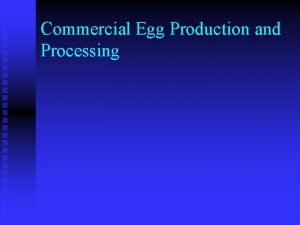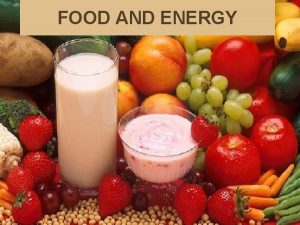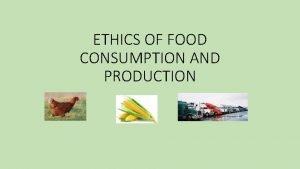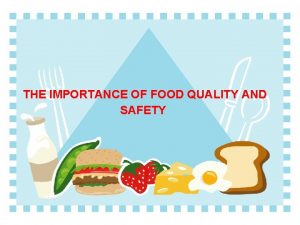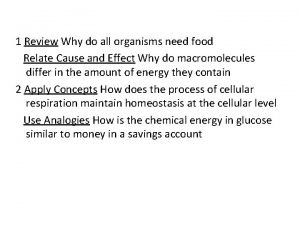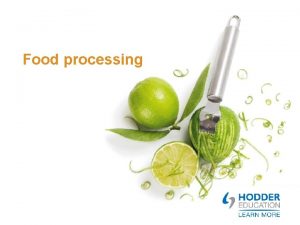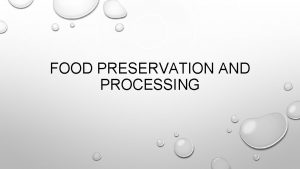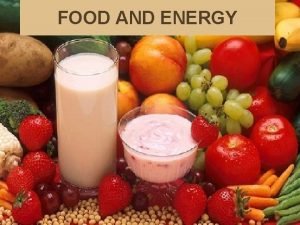Food processing and production What I need to











- Slides: 11

Food processing and production

What I need to know • What primary and secondary processing means How wheat is made into flour Wheat http: //resource. download. wjec. co. uk. • What wheat is ( how is it grown etc. ) s 3. amazonaws. com/vtc/2015 -16/1516_12/where. Food. Comes. From. html • Secondary processing of wheat: -different types of flour and their uses in cooking -Flour made into bread and pasta ( how this happens both domestically and commercially) Milk • Primary processing of milk ( how it is made safe to consume and meets consumers needs) • Different types of milks and their uses in cooking • Secondary processing of milk -Milk into butter, cream, yoghurt and cheese (how it is done and different types) -What the red tractor symbol means and how that relates to milk and wheat processing

How flour is milled Primary and secondary processing of Wheat Step 1: the wheat grains are blended with other varieties and washed to remove grit and dirt. What is it? Wheat grows particularly well in the UK although can be grown worldwide. It is easy and cheap to grow hence its popularity. The grain wheat is milled to make flour. Flour is used to make lots of different food products including bread, pasta, biscuits and cakes, Wheat grains are at the top of the plant they are closely packed together in clusters called ears. Each ear is made up of around 45 -50 grains Step 2: Huge rotating rollers crush the grains at varying speeds The crushed grain is sieved and this produces flour. Step 3: If white flour is wanted, the bran is removed by further rolling. A grain of wheat has 3 distinctive parts Bran layers- the course outer Wheat germ- a new plant would grow from the part Endosperm- the starchy store of food from which the plant grows Different parts of the wheat grain are used to make different types of flour Primary processing Flours can be defined by their extraction rate : that is how much of the whole grain is used Wholemeal flour Extraction rate of 100% means that nothing has been removed from it. It is light brown colour. It has the highest fibre content. Brown flour Extraction rate of 85 -90% ( 10 -15% of the grain is removed as bran White flour extraction rate of 70 -75% ( the bran, germ, fat and some of the minerals have been removed) UK law states that all flour apart from wholemeal flour has to be fortified with iron, calcium thiamin and niacin. This replaces the B vitamins that have been lost in processing This logo is often used on organically produced flour (no chemicals) The process can be adjusted to produce the required type of flour. Types of flour Uses Strong flour This has a higher gluten content, which is need in bread making flaky and choux pastry. The gluten is able to stretch after it has ben mixed with water and developed. Soft flour This is used for cake and pastry making and has a lowered gluten content Self raising flour This has a chemical raising agent added to it Gluten free flour Made from flours which do not contain gluten e. g. rice, tapioca, potato. Secondary processing of flour Other ingredients are then added to flour at home or in food factories to turn them into these four main products. Different flours give different tastes and textures. Bread Pasta ( fresh and dried) Biscuits Cakes

Primary and Secondary processing of milk Main types of milk in the UK There is a wide variety of milk available. Cows milk is the most popular in the UK. Other main sources are goats and sheep. Once the cows have been milked (this happens twice a day) it is stored in tanks at 4˚c until it is taken to a dairy to be processed. Whole Milk Has no fat removed and nothing added (must have a minimum of approximately 3. 5% fat). It is usually in blue labelled bottles Primary processing Homogenisation Milk is mainly water. It is an emulsion which has tiny drops of fat suspended in it. As oil and water do not mix the fat naturally rises to the top of the milk. However today we do not buy milk like that, this is because milk is homogenised. This is a process in which milk is forced at high pressure though small holes. This breaks up the fat globules so they are dispersed in the milk. Pasteurisation Heat treatment Most of the milk in the UK has been pasteurised. This is the prefer method. It is heated to a temperature of at least 72 c for a minimum of 15 seconds and a maximum of 25 seconds. It is then quickly cooled to below 6 c This kills harmful bacteria, has little effect on the nutritional value of the milk and extends the shelf life. Sterilised milk Heated to a temperature of above 100 c for approximately 10 -30 minutes and then is cooled quickly. It destroys nearly all the bacteria, however unlike pasteurised changes the taste and colour ( sweeter and browner due to the caramelisation of the milk sugars) It also destroys some B vitamins. One positive is that it can be stored, unopened in bottles or cartons for several months without being in a fridge, however once opened it must be treated as fresh. Semi skimmed milk is 1. 7% fat. It is usually sold in green labelled bottles. This is the most popular type of milk in the UK Skimmed milk is 0 -0. 5% (virtually fat free). It is usually sold in red labelled bottles. Vitamin A is artificially added. Slightly more calcium than whole milk. Less fat soluble B vitamins. Not recommend for children under the age of 5. Look out for this symbol on milk Channel island milk Higher in calories than whole milk as there is more fat. Therefore higher content of fat soluble vitamins A and D. Organic milk Comes from cows grazed in fields where there are no added chemical fertilizers. Tends to be more expensive due to these farming methods. Some milk producers are also using this symbol Other types of milk Milk can be purchased in other ways, the way these are processed changes their organoleptic properties (flavour, colour, texture), their uses and their shelf life. UHT (ultra heat treated milk) Heated to a temperature of at least 135 c for 1 second All bacteria is killed. Unopened packs have a longer shelf life, but must be treated as fresh once opened. Little effect on the nutritional content and flavour. Evaporated milk Condensed milk Dried milk

Cream Secondary processing of milk Cream is the fat found in the milk. It is separated from the milk by rotating it at a very fast speed. The cream is then pasteurised to destroy any harmful pathogenic bacteria and any enzymes that may cause spoilage and lead to a shorter shelf life. In the UK cream is categorised by how much fat it contains. Type Fat content (minimum) Use Single cream No less than 18% fat Coffee, pouring on desserts, adding to soups Double cream No less than 48% fat As above but can also be whipped for piping Whipping cream No less than 35% fat Used for whipping and piping Clotted cream No less than 55% fat Used in English cream teas. Local produce of Cornwall, Devon and Somerset Butter Cream is churned to separate the fat from the water. The fat is the butter. Unsalted butter- no additional ingredients added Salted butter- salt is added for flavour Clarified butter- butter is melted and the fat that rises to the top is separated and used for cooking Ghee- a form of clarified butter is used in Indian cooking Spreadable butter – butter that has oil added which means it is spreadable straight from the refrigerator Butter by law has to have a fat content of between 80 – 90%. There is no such thing as low fat butter or reduced fat butter. These are categorised as spreads. However they are sometimes marketed under the brand name which is confusing! Be careful Elmlea cream and margarine are not examples of secondary processing of milk as they do not contain any! Yoghurt Yogurt is made by fermenting milk with harmless bacteria. Most yoghurts are made with cows milk but it can be made with goats milk or soya. Low fat yoghurts are made with skimmed milk, richer ones with full fat milk. Milk is pasteurised To remove all harmful bacteria Milk is homogenised To distribute the fat particles evenly, resulting in a creamier texture Fruit or flavourings are then added Milk is incubated and the harmless bacteria is added This changes the lactose in the milk into lactic acid. The lactic acid causes the milk to coagulate/ thicken and gives its distinctive tangy taste Yoghurt is left to set until it reaches the right acidity level Cheese There are many different varieties of cheeses, some are traditionally made in the UK e. g. Cheddar. Others are from around the world e. g. Brie from France, Parmesan from Italy. They are made from different types of milk (mostly cows but sometimes goats). Slight variations in the methods of making can result in different flavours and textures of cheeses. A starter culture is added This changes the lactose in the milk into lactic acid. The lactic acid causes the milk to coagulate the protein in the milk, preserves the cheese and also helps develop the flavour Rennet is added and the mixture is left to set The enzyme in rennet coagulates the milk and turns it into solids- curds and whey For soft cheese the whey is left to drain away naturally. For hard cheese the curds are heated and piled on top of each other to release more whey The cheese is then milled and then salt may be added and the curds are pressed into moulds The cheese is left to ripen The temperature and humidity is controlled to produce different types of cheese. As the cheese ripens the colour, flavour and rind of the cheese develops. Types of cheeses Hard Cheddar , Parmesan Semi hard Cheshire, Wensleydale, Edam Soft ripened Brie, Camembert Blue Stilton, Roquefort, Gorgonzola Fresh Mozzarella, Cottage cheese Processed cheeses are: cheese slices (Kraft slices), Cheese Strings and spreadable cheese (Dairylea)




Making your own cheese at home Cottage cheese Cheese has always been a way of storing a surplus of milk for use when the cow or sheep were dry and making your own cheese at home is a great way to store any surplus milk you may find yourself with (method of food preservation). All cheeses are made from the coagulated lumps from milk – the curds – with the liquid part called the whey, hence curds and whey. Although a lactic starter can be used when making cottage cheese, it is not necessary, the same chemical reaction of turning the milk, or curdling, can be obtained from the use of vinegar or lemon juice which most people have in their kitchen. Equipment to Make Cottage Cheese: Ingredients for Cottage Cheese: 2 pints (1200 ml) semi-skimmed or skimmed milk Saucepan – stainless steel or enamelled (avoid aluminium) 2 tablespoons (30 ml) lemon juice or white vinegar Pinch of salt Wooden Spoon Fine Sieve preferably metal Method for Cottage Cheese: Pour the milk into the saucepan. Heat on hob until it is very hot, but do not boil, stirring occasionally with the wooden spoon. Allow to cool for a couple of minutes. Add 2 tablespoons (30 ml) of lemon juice or vinegar. Stir and watch the hot milk separate into the curds and whey. Allow to cool further. Pour the curds and whey through a sieve to catch the curds. www. allotment-garden. org

Video links Jimmy's food factory: Homogenisation http: //www. bbc. co. uk/programmes/p 011 t 4 p 1 Jimmy's food factory: cheese/ processed cheese http: //www. bbc. co. uk/programmes/p 011 lyf 6 Jimmy's food factory: Yoghurt http: //www. bbc. co. uk/programmes/p 011 lc 0 f How wheat is made into flour http: //resource. download. wjec. co. uk. s 3. amazonaws. co m/vtc/2015 -16/15 -16_12/where. Food. Comes. From. html

Keywords Primary processing Secondary processing Chemical raising agent Coeliac disease Extraction rate Fortified Gluten Emulsion Homogenisation Nutritional value Pasteurised Sterilisation Enzymes Meaning/ examples
 Pre production production post production
Pre production production post production In-line production process eggs
In-line production process eggs Unit 2 food food food
Unit 2 food food food Eltonian pyramid
Eltonian pyramid Need food and energy
Need food and energy Neighborhood processing
Neighborhood processing Primary food production
Primary food production What is interactive processing
What is interactive processing Ethics of food production and consumption
Ethics of food production and consumption Why do amebas need to obtain food
Why do amebas need to obtain food Why food quality is important
Why food quality is important Why do organisms need food
Why do organisms need food

